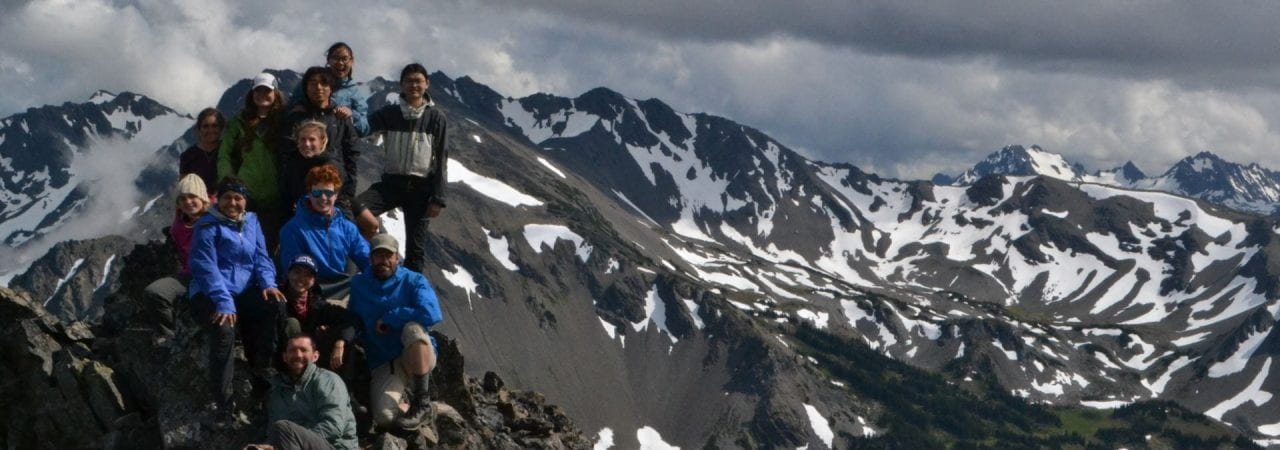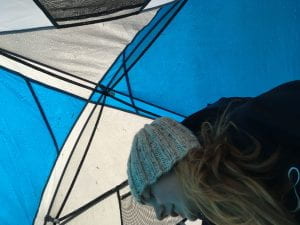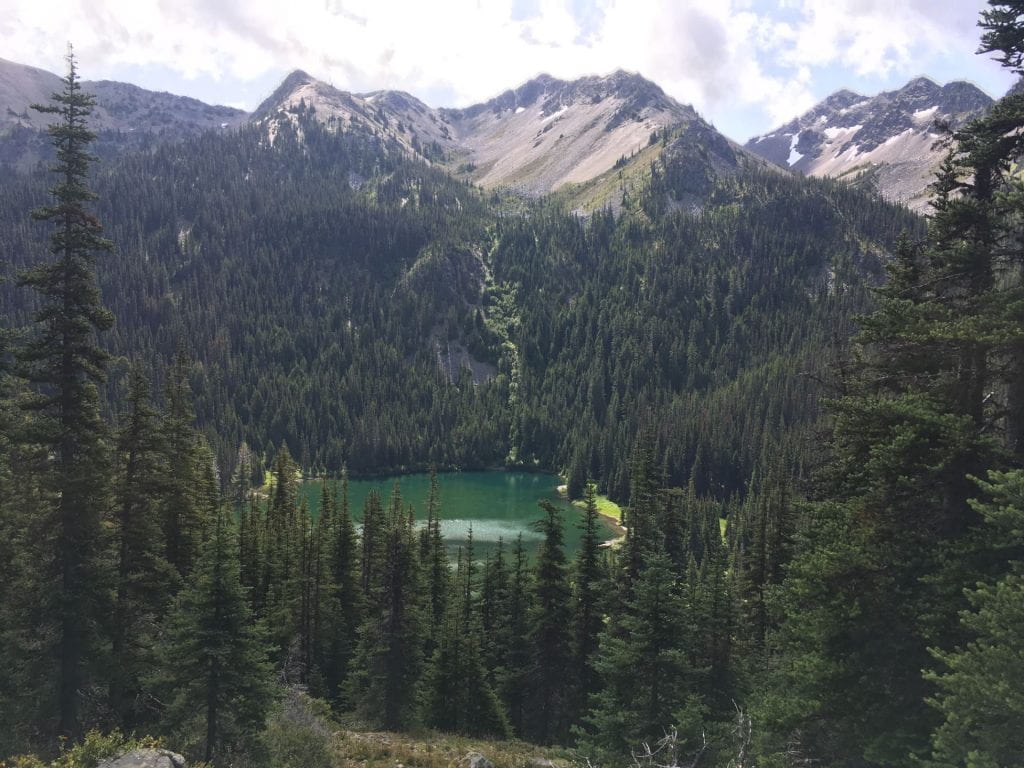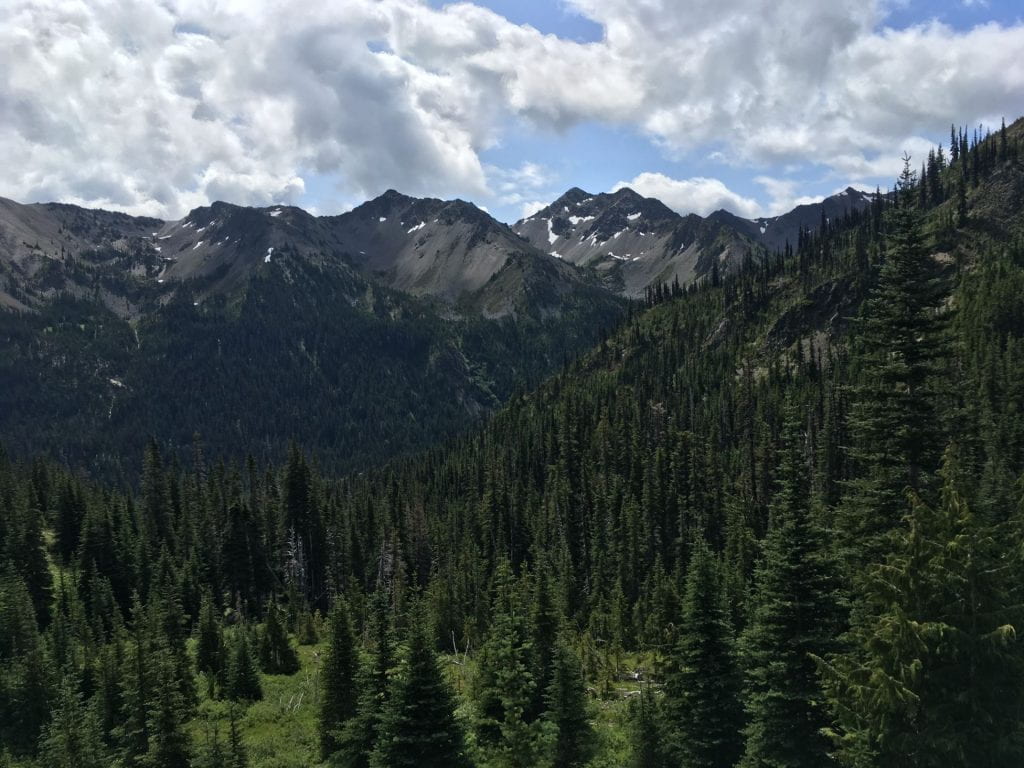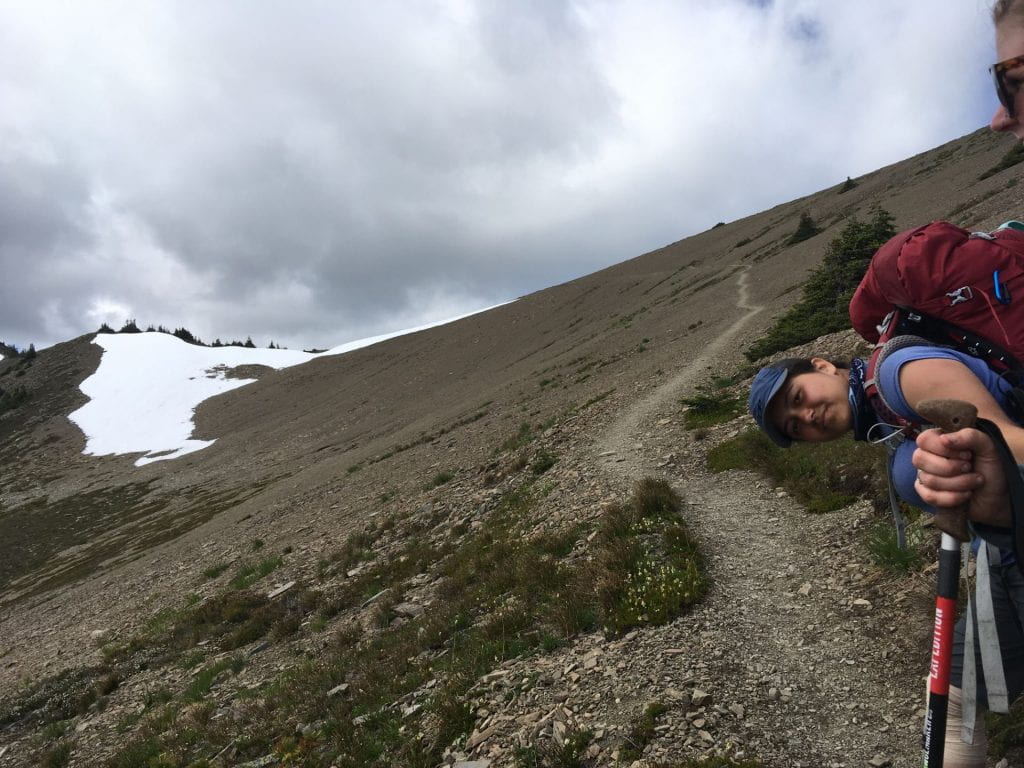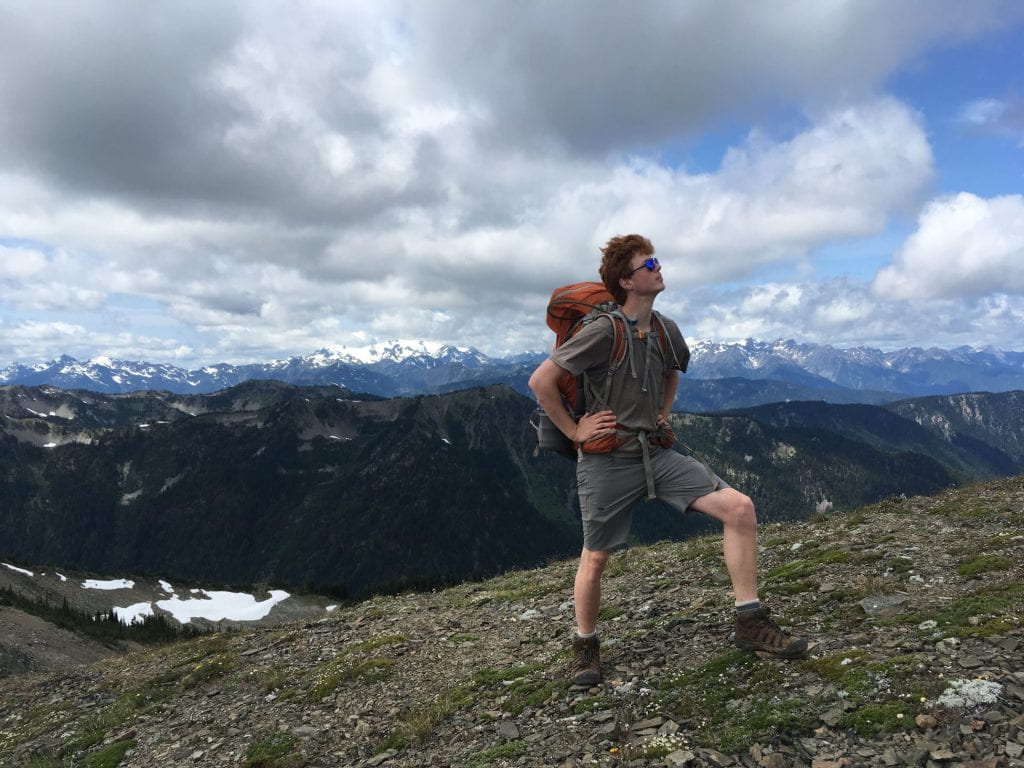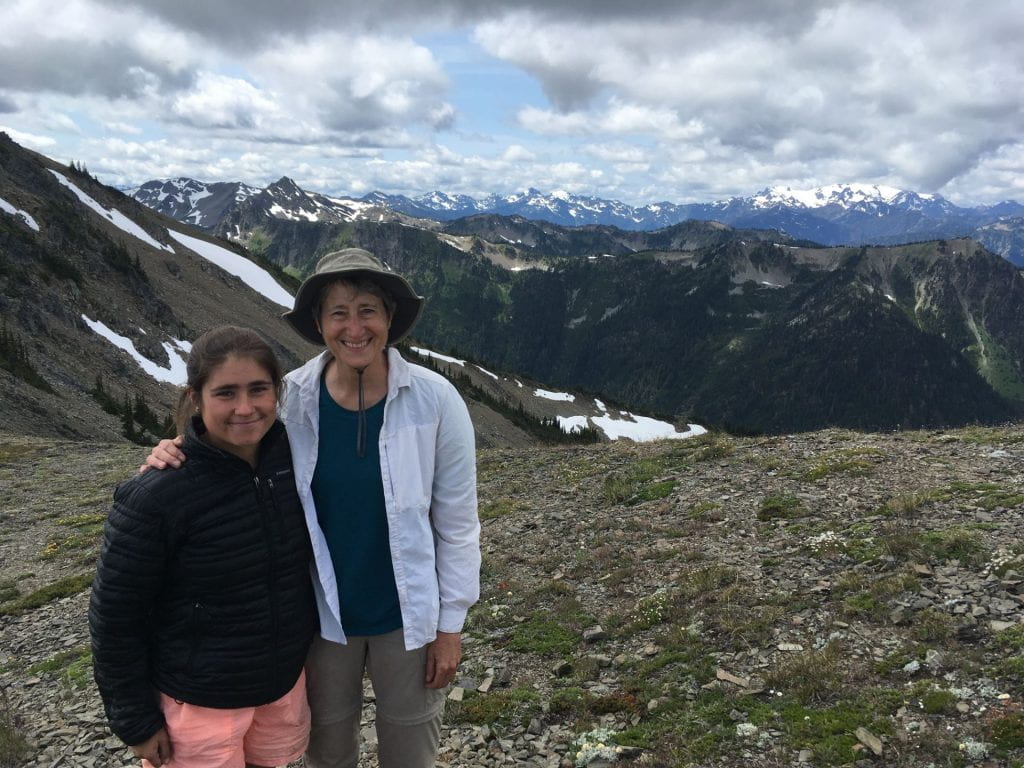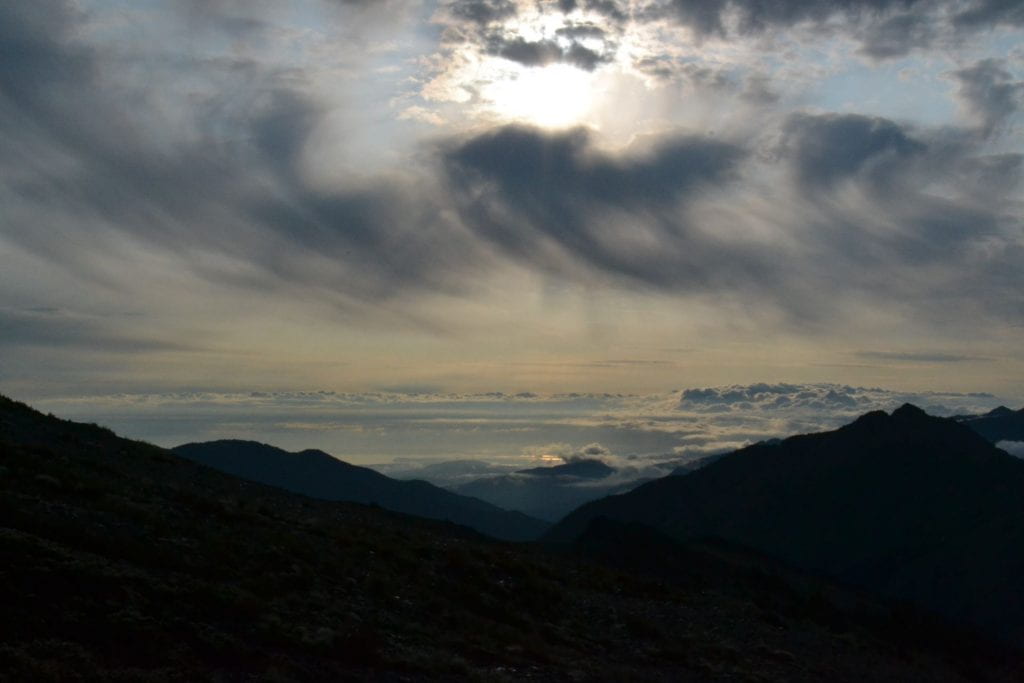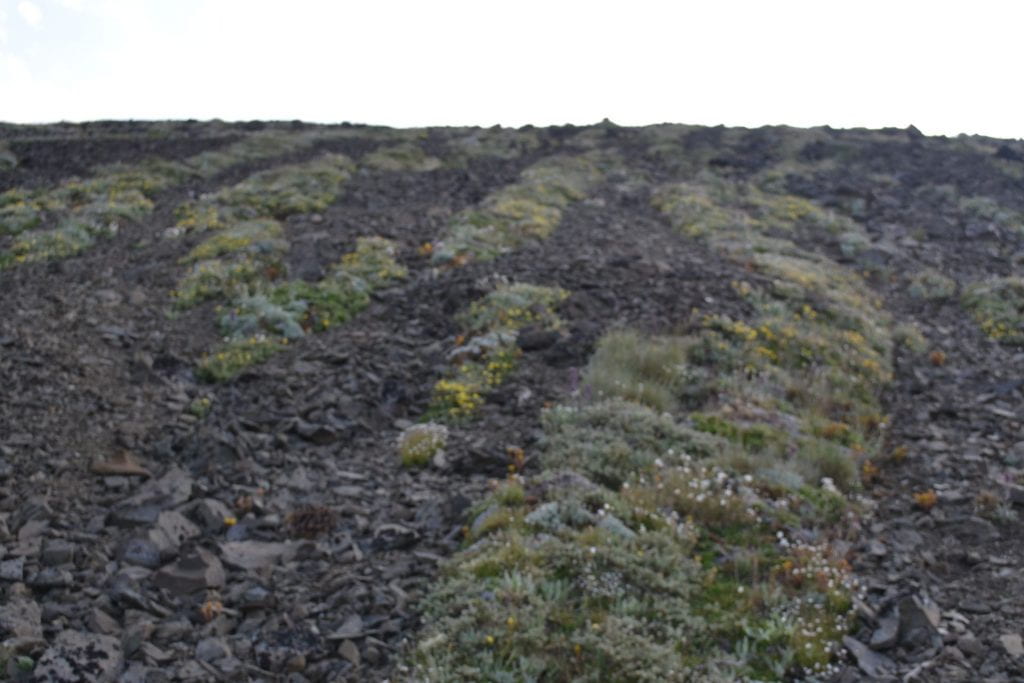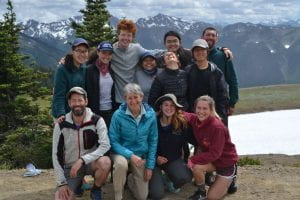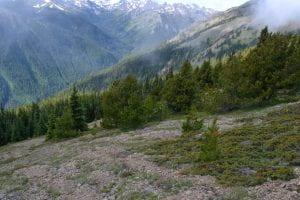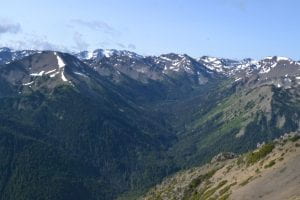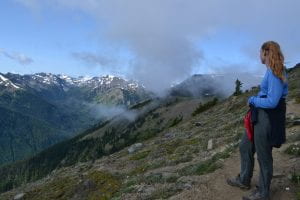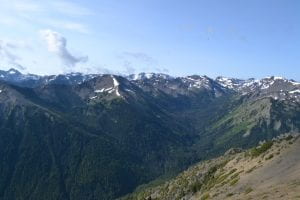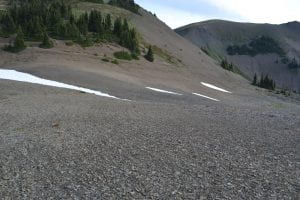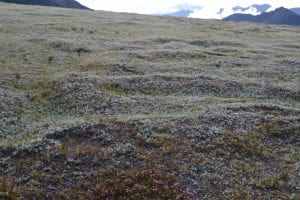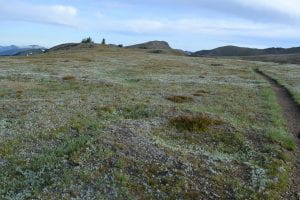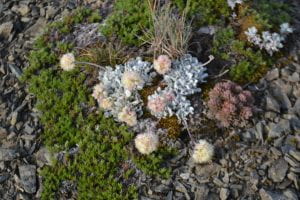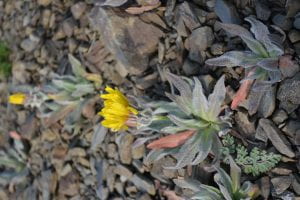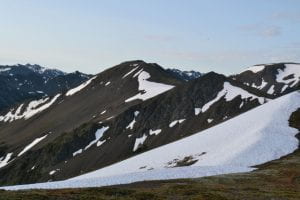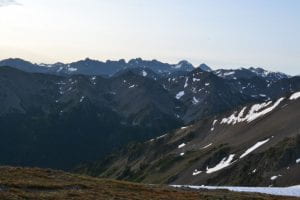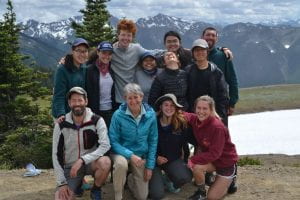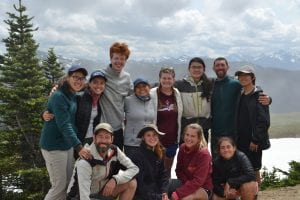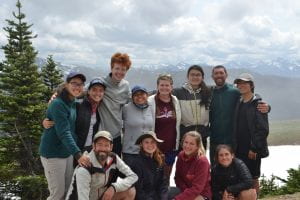Ah, day 9 – July 14th. The very final leg of our epic journey through the Olympic wilderness followed swiftly by an overwhelming reentry into civilization. The tone among the group was emotional and reflective, everyone wanted to soak up the last of this once-in-a-lifetime experience we had just shared. All day my peers and I reflected on the duality of our feelings; we were all excited for some aspects of reentry but dreading others. Zacharia and I discussed on our final hike – as we traced the curves of shimmering blue Moose lake and headed north west towards the snow patched rock faces of Lilian ridge – how we were dreading returning to cell phone service and experiencing the bombardment of messages and technology dragging us back to our everyday realities.
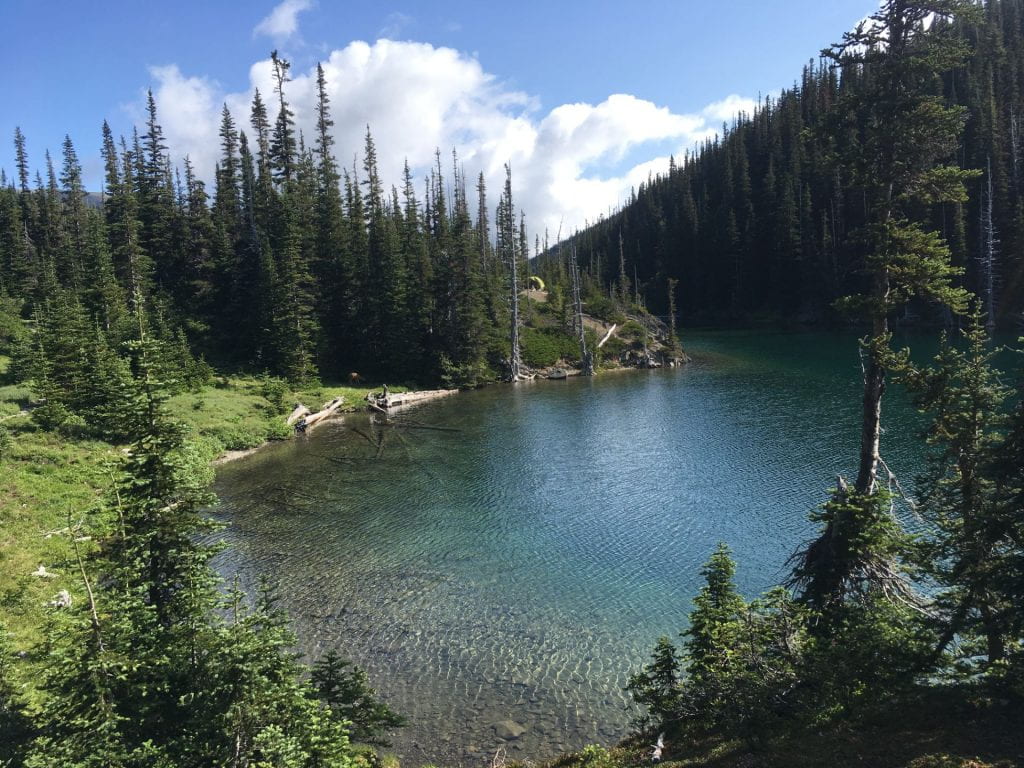
Moose Lake, the location of our last campsite on night 8 and the body of water in which the final dip occurred
My day began very early in the morning – I was awoken by Tim attempting to wake Katie Spires from outside our tent. Tim and Katie (the true MVPs of the day) were tasked with leaving camp well before the rest of us had even awoken. They hiked to obstruction point (where we would all eventually meet up) around 5:30 am. From there, these champions of the trail ran 8 miles west back to Deer Park, where our journey had begun. Here they retrieved the cars and drove them out of the park, through Port Angeles and back around to Obstruction Point. The night before, Katie S., Hanna and I had had our final party tent before bedtime rumpus chat. We snuggled in our sleeping bags for the 8th night in a row, now completely comfortable with sleeping in the outdoors. We commented on each others’ “mountain women” odors and said some very silly things before realizing that our loud voices were surely within earshot of every other tent, especially Sally Jewell’s which was right beside ours. Alas, the wilderness had gotten inside our souls and made us completely giddy. We talked about the stern and religious demeanor of John Muir and other founding white male conservationists – Katie said, “that nature is so serious is a male construct”. After sharing so many belly shaking laughs in and outside that tent in the past days, Hanna and I agreed. When Tim whispered Katie’s name from outside our tent that morning, all three of us woke up – Hanna and I enthusiastically mumbled some final words of encouragement to Katie. Then Tim and Katie were off and the rest of us slumbered a few more hours.
The rest of the group’s day began with Katie Keil’s voice welcoming us all to wake up. Hanna and I, in our classic sleepy head fashions snoozed for at least 15 more minutes. But getting up and out of the tent turned out to be a blessing. After so many days of rain, fog or partial cloud cover – the beginnings of a gorgeous day shinned upon us. The clouds were clearing, and rays of sun were warming our weathered skin and drying out our still soggy socks and boots. I, like many others, laid out all my gear in patches of sunshine around camp – incredibly, most of it dried out nicely. Rain flies came off tents and hiking boots were scattered about. Our final group breakfast was a funny affair. Most of us were quite tired of oatmeal and granola. Tim had commandeered our cook groups brown sugar on accident, other groups were out of brown sugar, Zacharia sweetened his oatmeal with hot cocoa powder, Diana abstained from eating anything at all and Katie Keil came to her wits end with a bowl of mush. Another bowl of thick tasteless goo was just about more than she could handle and not even Zacharia was willing to finish what Katie didn’t want to. Sally sympathized saying that she’d lost her appetite for oatmeal pretty quickly after getting into backpacking.
Seated around the stone slab we all chatted over our last breakfast. Sally shared some stories of her early inroads into mountaineering and experiencing wilderness. Growing up in Renton, she explored many of Washington’s iconic wilderness from a young age, including her first summit of Rainer – accomplished at age 15. It became clear from Sally’s stories that her time in wilderness has shaped her soul and attitude and why she values conservation and environmental work so highly – a bond with the wild lies at the base of her motivation. Story after story revealed that Sally has also guided many novices through their first experiences in wilderness. She has been enriched by witnessing these people open up to the power and beauty of nature. This has clearly been a part of Sally’s deep commitment to service throughout her lifetime – a generosity of self which extends to her outdoor expertise and her desire that others have the chance to experience the joy she has felt in the wild.
This same attitude of joyful appreciation for wilderness shone through from Sally Jewell after breakfast, when a group of us (Diana, Autumn, Jonathan, Zacharia and I) decided to go for one final dip-of-the -day. Talk of skinny dipping got around and far from disapproving, Sally seemed to quietly encourage this particular enjoyment of nature. She kept distance from the lake when we went to dip but she smiled and spoke positively when we left and came back, as if she had an innate understanding of being young and wanting to feel wild in the wilderness. I know skinny dipping might seem like a silly and frivolous thing to focus on, but to me these particular moments of the trip were deeply meaningful. As we all made our way down to Moose lake, avoiding some aggressive deer, we giddily smiled at each other blushing and laughing. The emerald green lake opened up the terrain ahead, pushing aside stands of sub-alpine fir. Looking any direction yielded views of patchwork snow on rolling grey peaks. In this free and scarcely human populated place we could all be free. Trusting each other completely none of us felt judged and our self-conscious inhibitions were dampened. For me personally, I know I was less obsessed with body image than I had been in a while. Free from mirrors for days, I just felt like a human in the wild, no concerns about specific unlikable parts of my body were on my mind. We all entered into the vulnerable state of nakedness together and waded into the icy water up to our necks. The splashing green water revived and rejuvenated sending freezing jolts of energy through my body. We were quickly in and out and back into our clothes but now feeling refreshed and free (of both societal constraint and the layer of sweat and grim that previously caked our skin). Thank goodness for my dip-a-day pals – the feeling of dampened self-consciousness is something that has continued with me in the days since.
Soon enough our time at Moose lake ended. We needed to set out for our hike to Obstruction Point in order to meet Tim and Katie in a timely fashion. We were on the trail by 10:15 am. The trail curved around Moose lake and then took us gradually higher towards the north east. We switch-backed up to Lilian ridge as our last great elevation gain of the trip. We were far from being in a rush– we had given ourselves plenty of time to make the journey and we were all content to slow down and soak up the last drops of wilderness. As we ascended the vegetation transformed, subalpine fir and yellow cedar forest faded slowly as we emerged into rocky slopes sparse with brush and subalpine wildflowers. Hanna was in the lead for this hike, 9 days on her untreated knee and she was still climbing slow and steady with every bit of positivity inherent in her character. No one was eager to go faster than Hanna’s pace for each time we stopped for a break we turned to face the valley and far peaks which we were slowly rising above. Each stop along the trail offered a new and more spectacular view over where we had come from. Moose lake faded in the distance. The very final leg of the ascent was a long steadily graded dirt trail through a field of lose rock. We could see the pass not so far in the distance and our sore (yet now well trained) legs brought us ever closer. For many of us, this was the final big physical challenge of a trip that pushed our boundaries both physically and mentally. For me this climb symbolized the peak of the accomplishment – the final reminder that I am always capable of more than I think.
Once on top of Lilian Ridge any annoyance at the physical challenge of hiking up a thousand feet of elevation with a 50 lbs pack vaporized and vanished in wake of the sparkling prize – the views both the west and east were impeccable. To the west Olympus shone white on crystal blue with her glaciated peaks piercing the clouds and around her the whole majesty of the range meandering on. And to the east our view dropped thousands of feet down into rich green valleys, the slopes on either side of which obscured by a thick cover of puffy white clouds. We stopped here for a break. We took in the views and took snapshots, many us took commemorative photos with Sally – Mount Olympus as our backdrop. The wonderful weather had continued. I think we all felt a little giddy about actually having a whole day of sun, blue skies and white clouds that didn’t threaten rain. The stunning mountain wilderness still very much gripped us, although we were starting to see more and more signs of civilization approaching. We’d been passed on the trail by a Washington Conservation Corps trail crew of about 15. And up on the pass several people hiked through on their way from Obstruction Point. We all realized we were close to the end.

Oval-leaf buckwheat thriving in the desert-like conditions of Lillian Ridge. Tiny leaves, covered with hair, prevent moisture loss from the wind and sun.
The final leg of the hike took us from Lillian pass North along Lillian ridge. Walking the top of the ridge offered continual beautiful views to the east and west. Many of noticed on the slopes of Lillian ridge the phenomenon of stripes of vegetation and rocks organized by size which Tim had mentioned to us on Cameron pass. We even got to hike through a couple more patches of snow fields, practicing our heal digging technique a few last times and stopping to taste a few more patches of watermelon snow. The stretch from Lillian pass to Obstruction point was only a couple more miles and as we went, we encountered more and more folks hiking in the opposite direction – signs that cars were near. And sure enough, before too long Z and I (who were in the front) saw the unnatural sheen of large motorized machines organized into neat parking strips in the distance. It was a strange way to be introduced to civilization, all these giant cars designed to bring you miles and miles after we had come from miles and miles on just our feet. Zachariah and I arrived in the Obstruction Point parking lot very nearly at 2 pm and the rest of the group trickled steadily down the last slop of Lillian ridge to join us. For the last time we cheered on members of our group as they neared the finish line, except this was really the finish line of our hike.

ZW and Jonathan reach Obstruction Point, where trail meets road. Obstruction Point marks the the defeat (by terrain and money) of an effort by the CCC to connect a road across high ridges to Deer Park. While roads are a unique feature of many of our national parks, and an accessible way for many to experience wilderness views, they are controversial for their effects on ecosystems and backcountry recreation. After 9 powerful days in the backcountry we are deeply thankful that Olympic is still a place where one can hike for weeks on end without crossing a road.
Soon enough Katie and Tim arrived, remarkably timely were they for the much longer journey they had that day. We were soon engulfed by the chaos of getting organized – emptying packs of borrowed gear, collecting all our garbage and hauling things into the vans. But wonderfully, Katie and Tim had made the executive decision to buy a potluck lunch for us to share rather than have us eat lunch in town. We made sandwiches and gorged ourselves on fruit, guacamole and ginger beer, all while getting to experience the epic view of Mount Olympus and the company of deer and chipmunks for a little longer. When we had all had our fill of wonderful non-backpacking food, we gathered for a final group discussion with Sally Jewel. Standing in a circle on the side of the road with Olympus to our south west we all shared some reflective thoughts on the journey. Tim asked us all to consider a favorite moment or moments and to share something we learned. Many of shared touching, personal and extremely thoughtful reflections, there were more than a few tears as people thanked the group for the energy of positivity, support and inclusion. But there was an especially special moment when Sally touched us all by breaking into tears as she shared her reflections. She spoke of the planetary tragedies that our generation is being passed down to fix, but her tears seemed more inspired by hope. Sally brought many of us to tears ourselves by expressing her faith in us, in the passion and thoughtfulness that we had brought to the course. Later, when we were writing a card for Sally in the Olympic ranger station parking lot, I told her how she had made me feel in that moment – “adults like you who have led such extraordinary and successful lives yet still care so deeply about doing good by people and the world remind me that a fulfilling life is bigger than self and to have a purpose is to fight for good”.
To conclude my reflection on this day and on the trip, I’d like to share a version of my response to Tim’s question:
Some of my favorite moments of the trip were from camping below Grey Wolf Pass and going up and over the pass the next day. This snowy rugged landscape was intensified during our visit by almost constant high winds, swirling fog and incessant sheets of rain. Although the views from this alpine area were obscured by the weather, I don’t think I’ve ever experienced wilderness quite so wild, epic and beautiful as that. The entire time we were there was like a long drawn out reminder of mother natures power and majesty. Here, our human bodies were vulnerable to the harsh reality of the wild and with no human society near, our place as simply one among many species surviving on a bountiful yet unforgiving planet became real. I was absolutely energized by this feeling. I lost the wondering thoughts of worry from my “real” life and I was so totally focused on the present moment and place. Hiking up to the pass the rain and wind, across fields of snow and up rocky slopes, that was probably one of the most freeing moments of my life. I had to focus on the hike, the weather and landscape offered risk and fear but not too much and my mind was overwhelmed by the epic-ness of it all. I truly felt like a human, an individual free in the wild world.
I think these intense moments have inspired a lot of my learning from the trip. What’s the value in everyone getting the chance to experience wildness – humility. How can human beings with built civilizations which give the illusion of dominance over nature understand the true power and beauty of wilderness without the opportunity to be humbled by mother nature’s unforgiving yet stunning beauty? I really believe now that it would be hard for someone to experience our journey and not come out the other end with an inherent sense that such wildness needs to be protected. Spaces like Olympic national park offer us this experience of wildness and also a comparison – to see what we are making of the world from what it was (roughly). Without such a comparison we may lose sight of the true nature of planet and forget that everything we have built is on the back of the natural resources and systems we were gifted. Its all a way to gain a little perspective, humble ourselves and learn to respect our maker so that we do not destroy ourselves fighting against her flow.
Mother nature gave us one last show of mystery, beauty and dominance as we drove down the road to leave the park. A thick and massive cloud of fog came over our vehicles and the ridge around us, for several minutes we could only see a few feet ahead of the car. It was as if the world was reminding us one last time of the power it holds while simultaneously nature was telling us not to leave, wanting to hold us all in the wild for a little longer, hear out laughs and feel our awe.
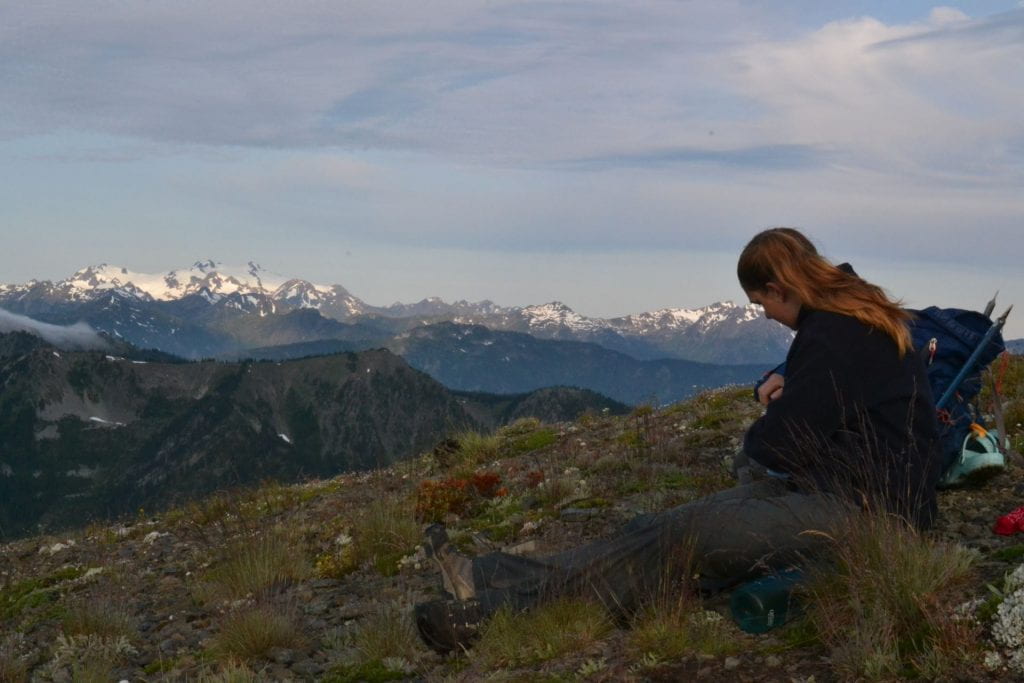
Sunrise on Mount Olympus. Breakfast on the ridge for Katie and Tim on the quest to shuttle the vans.

The carnivorous butterwort, seen growing in a seep at the side of the trail out of Grand Valley. Note the flies stuck to the leaves.
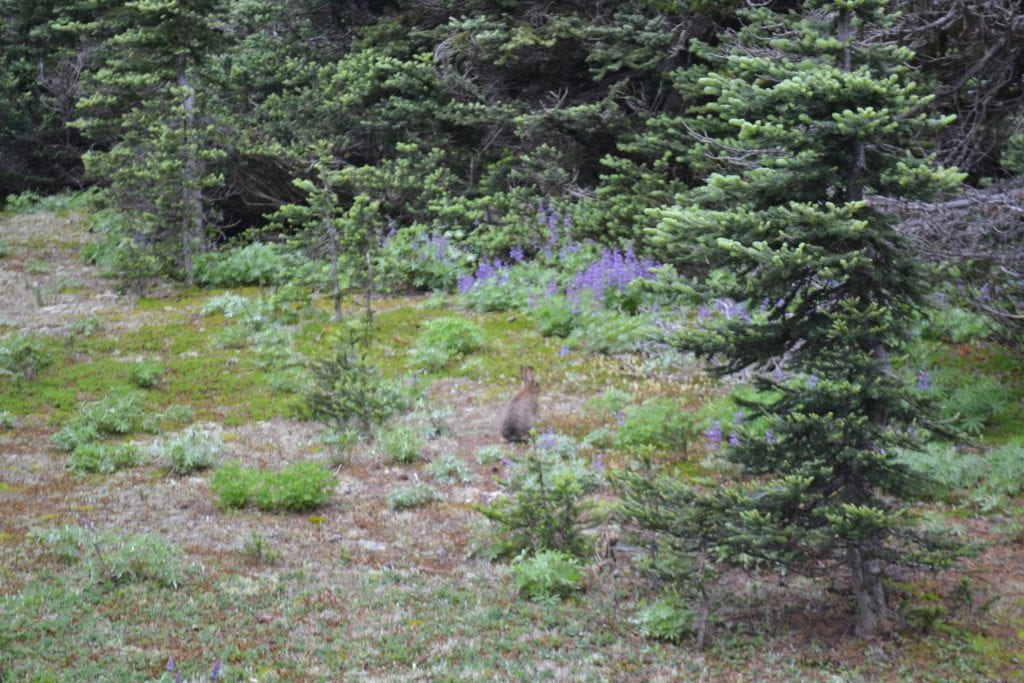
A snowshoe hare on the east side of Maiden Peak, one of several encountered by Katie and Tim on the quest for the vans.

Amazing rock stripes near Obstruction Point, caused by freezing and thawing in the surface of this scree field.
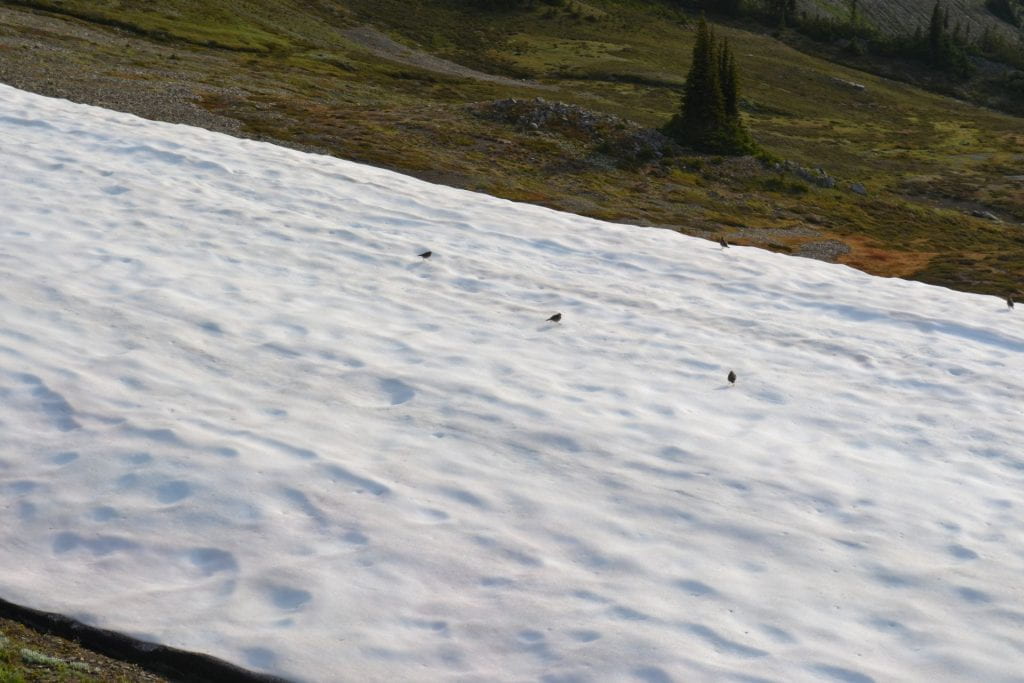
American pipits gleaning insects off of a small snow field. Snowfields are a critical piece of habitat for many alpine bird species. The shrinking of snowfields is negatively impacting birds of the alpine, not to mention snow-melt flowers and scavenging insects associated with snowfields.

Lakes lying in small bowls carved by small glaciers that formed and persisted on this ridge after the Little Ice Age. Is there still ice buried under the scree? The tourquoise blue of these lakes suggests this as a possibility. Note the clonal islands of subalpine fir on the hillside, spreading “skirts” around the mother tree.
